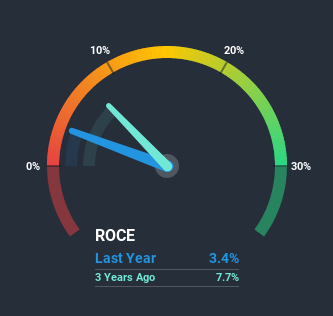Returns On Capital At Joh. Friedrich Behrens (BST:JFB) Paint An Interesting Picture

What trends should we look for it we want to identify stocks that can multiply in value over the long term? Ideally, a business will show two trends; firstly a growing return on capital employed (ROCE) and secondly, an increasing amount of capital employed. Put simply, these types of businesses are compounding machines, meaning they are continually reinvesting their earnings at ever-higher rates of return. However, after investigating Joh. Friedrich Behrens (BST:JFB), we don't think it's current trends fit the mold of a multi-bagger.
What is Return On Capital Employed (ROCE)?
For those that aren't sure what ROCE is, it measures the amount of pre-tax profits a company can generate from the capital employed in its business. The formula for this calculation on Joh. Friedrich Behrens is:
Return on Capital Employed = Earnings Before Interest and Tax (EBIT) ÷ (Total Assets - Current Liabilities)
0.034 = €2.0m ÷ (€106m - €48m) (Based on the trailing twelve months to June 2020).
Therefore, Joh. Friedrich Behrens has an ROCE of 3.4%. Ultimately, that's a low return and it under-performs the Building industry average of 10%.
See our latest analysis for Joh. Friedrich Behrens

Historical performance is a great place to start when researching a stock so above you can see the gauge for Joh. Friedrich Behrens' ROCE against it's prior returns. If you want to delve into the historical earnings, revenue and cash flow of Joh. Friedrich Behrens, check out these free graphs here.
What Does the ROCE Trend For Joh. Friedrich Behrens Tell Us?
On the surface, the trend of ROCE at Joh. Friedrich Behrens doesn't inspire confidence. Around five years ago the returns on capital were 17%, but since then they've fallen to 3.4%. However it looks like Joh. Friedrich Behrens might be reinvesting for long term growth because while capital employed has increased, the company's sales haven't changed much in the last 12 months. It may take some time before the company starts to see any change in earnings from these investments.
On a side note, Joh. Friedrich Behrens has done well to pay down its current liabilities to 45% of total assets. So we could link some of this to the decrease in ROCE. What's more, this can reduce some aspects of risk to the business because now the company's suppliers or short-term creditors are funding less of its operations. Some would claim this reduces the business' efficiency at generating ROCE since it is now funding more of the operations with its own money. Keep in mind 45% is still pretty high, so those risks are still somewhat prevalent.The Key Takeaway
To conclude, we've found that Joh. Friedrich Behrens is reinvesting in the business, but returns have been falling. It seems that investors have little hope of these trends getting any better and that may have partly contributed to the stock collapsing 88% in the last year. In any case, the stock doesn't have these traits of a multi-bagger discussed above, so if that's what you're looking for, we think you'd have more luck elsewhere.
One final note, you should learn about the 4 warning signs we've spotted with Joh. Friedrich Behrens (including 3 which are significant) .
If you want to search for solid companies with great earnings, check out this free list of companies with good balance sheets and impressive returns on equity.
If you decide to trade Joh. Friedrich Behrens, use the lowest-cost* platform that is rated #1 Overall by Barron’s, Interactive Brokers. Trade stocks, options, futures, forex, bonds and funds on 135 markets, all from a single integrated account. Promoted
If you're looking to trade Joh. Friedrich Behrens, open an account with the lowest-cost platform trusted by professionals, Interactive Brokers.
With clients in over 200 countries and territories, and access to 160 markets, IBKR lets you trade stocks, options, futures, forex, bonds and funds from a single integrated account.
Enjoy no hidden fees, no account minimums, and FX conversion rates as low as 0.03%, far better than what most brokers offer.
Sponsored ContentNew: Manage All Your Stock Portfolios in One Place
We've created the ultimate portfolio companion for stock investors, and it's free.
• Connect an unlimited number of Portfolios and see your total in one currency
• Be alerted to new Warning Signs or Risks via email or mobile
• Track the Fair Value of your stocks
This article by Simply Wall St is general in nature. It does not constitute a recommendation to buy or sell any stock, and does not take account of your objectives, or your financial situation. We aim to bring you long-term focused analysis driven by fundamental data. Note that our analysis may not factor in the latest price-sensitive company announcements or qualitative material. Simply Wall St has no position in any stocks mentioned.
*Interactive Brokers Rated Lowest Cost Broker by StockBrokers.com Annual Online Review 2020
Have feedback on this article? Concerned about the content? Get in touch with us directly. Alternatively, email editorial-team (at) simplywallst.com.
About BST:JFB
Joh. Friedrich Behrens
Develops, manufactures, and sells fastening technology for wood and wood-like materials worldwide.
Weak fundamentals or lack of information.
Market Insights
Community Narratives



